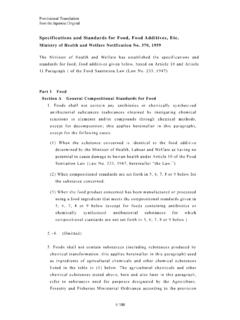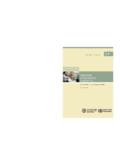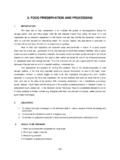Transcription of COMPENDIUM OF FOOD ADDITIVE SPECIFICATIONS
1 Joint FAO/WHO Expert Committee on food Additives82nd Meeting 2016 COMPENDIUMOF food ADDITIVESPECIFICATIONSCOMPENDIUM OF food ADDITIVE SPECIFICATIONSCOMPENDIUMOF food ADDITIVESPECIFICATIONSF A O J E C F A M o n o g r a p h sISSN 1817-7077 FAO / WHO1919 Joint FAO/WHO Expert Committee on food Additives82nd Meeting 2016 This document contains food ADDITIVE specification monographs , analytical methods, and other information prepared at the eighty-second meeting of the Joint FAO/WHO Expert Committee on food Additives ( jecfa ), which was held in Geneva, Switzerland, 7 - 16 June 2016. The specification monographs provide information on the identity and purity of food additives used directly in foods or in food production. The main three objectives of these SPECIFICATIONS are to identify the food ADDITIVE that has been subjected to testing for safety, to ensure that the additives are of the quality required for use in food or in processing and to reflect and encourage good manufacturing practice.
2 This publication and other documents produced by jecfa contain information that is useful to all those who work with or are interested in food additives and their safe use in 1 26/04/2016 15:05:26 COMPENDIUMOF food ADDITIVE SPECIFICATIONSJ oint FAO/WHO Expert Committee on food Additives82nd Meeting 2016F A O J E C F A M o n o g r a p h s19 ISSN 1817-7077 food AND AGRICULTURE ORGANIZATION OF THE UNITED NATIONS WORLD HEALTH ORGANIZATIONRome, 2016 The designations employed and the presentation of material in this information product do not imply the expression of any opinion whatsoever on the part of the food and Agriculture Organization of the United Nations (FAO) or of the World Health Organization (WHO) concerning the legal status of any country, territory, city or area or of its authorities, or concerning the delimitation of its frontiers or boundaries. The mention of specific companies or products of manufacturers, whether or not these have been patented, does not imply that these are or have been endorsed or recommended by FAO or WHO in preference to others of a similar nature that are not mentioned.
3 All reasonable precautions have been taken by FAO and WHO to verify the information contained in this publication. However, the published material is being distributed without warranty of any kind, either expressed or implied. The responsibility for the interpretation and use of the material lies with the reader. In no event shall FAO and WHO be liable for damages arising from its use. ISBN 978-92-5-109494-5 FAO/WHO 2016 FAO and WHO encourage the use, reproduction and dissemination of material in this information product. Except where otherwise indicated, material may be copied, downloaded and printed for private study, research and teaching purposes, or for use in non-commercial products or services, provided that appropriate acknowledgement of FAO and WHO as the source and copyright holder is given and that their endorsement of users views, products or services is not implied in any way. All requests for translation and adaptation rights, and for resale and other commercial use rights should be made via or addressed to FAO information products are available on the FAO website ( publications) and can be purchased through SPECIAL NOTE While the greatest care has been exercised in the preparation of this information, FAO expressly disclaims any liability to users of these procedures for consequential damages of any kind arising out of, or connected with, their use.
4 VTABLE OF CONTENTS Table of contents v List of participants vii Introduction ixSpecifications for certain food additives 1 2 5 9 15 19 23 28 77 80 85 90 94 99 106 112 Allura red AC Aspartame Carob bean gum Carob bean gum (clarified)Cassia gum Citric and fatty acid esters of glycerol Lutein esters from tagetes erecta Modified starches (1400-05, 1410,1412-1414, 1420, 1422, 1440, 1442, 1450, 1451) Octanoic acid Octenyl succinic acid (OSA) modified gum arabic Pectin Quinoline yellow Rebaudioside a from multiple gene donors expressed in yarrowia lipolytica Rosemary extract Steviol glycosides Tartrazine Xanthan gum 116 Analytical methods 120 Total colouring matters content (Volume 4) 120 Purity tests for modified starches 132 SPECIFICATIONS for certain flavouring agents 136 Spectra of certain flavouring agents 144 Annex 1: Summary of recommendations from the 82nd jecfa 151 Annex 2: General information 158 Annex 3: Future work and recommendations 162 12viiLIST OF PARTICIPANTS JOINT FAO/WHO EXPERT COMMITTEE ON food ADDITIVES, 82nd MEETING Geneva, 7 16 June, 2016 Members Ms J.
5 Baines, food Standards Australia New Zealand, Canberra, Australian Capital Territory (ACT), Australia Dr S. Barlow, Brighton, East Sussex, England, United Kingdom Dr D. Benford, Risk Assessment Unit, food Standards Agency, London, England, United Kingdom Dr M. DiNovi, Division of Biotechnology and GRAS Notice Review, Office of food ADDITIVE Safety, Center for food Safety and Applied Nutrition, United States food and Drug Administration, College Park, Maryland, United States of America (USA) Dr D. Folmer, Division of Petition Review, Office of food ADDITIVE Safety, Center for food Safety and Applied Nutrition, United States food and Drug Administration, College Park, Maryland, USA Dr Y. Kawamura, Division of food Additives, National Institute of Health Sciences, Tokyo, Japan Dr A. Mattia, Division of Biotechnology and GRAS Notice Review, Office of food ADDITIVE Safety, Center for food Safety and Applied Nutrition, United States food and Drug Administration, College Park, Maryland, USA (Chairperson) Ms I.
6 Meyland, Birker d, Denmark (Vice-Chairperson) Dr U. Mueller, food Standards Australia New Zealand, Barton, ACT, Australia (Joint Rapporteur) Dr G. Pascal, Le Breuil, Saint Alyre d Arlanc, France Dr J. Schlatter, Zurich, Switzerland Dr M. Veerabhadra Rao, Department of the President s Affairs, Al Ain, United Arab Emirates Ms Wallin, Helsinki, Finland (Joint Rapporteur) Professor Williams, Department of Pathology, New York Medical College, Valhalla, New York, USA Secretariat Dr Barrows, United States food and Drug Administration, College Park, Maryland, USA (FAO Expert) Dr R. Cantrill, AOCS, Urbana, IL, USA (FAO Expert) Dr E. Dessipri, General Chemical State Laboratory, Athens, Greece (FAO Expert) Mr M. Feeley, Bureau of Chemical Safety, food Directorate, Health Canada, Ottawa, Ontario, Canada (WHO Expert) Dr B. Fields, food Standards Australia New Zealand, Barton, ACT, Australia (WHO Expert) Ms Z. Gillespie, Bureau of Chemical Safety, food Directorate, Health Canada, Ottawa, Ontario, Canada (WHO Expert) Mrs F.
7 Hill, food Standards Agency, London, England, United Kingdom (WHO Expert) viiiDr X. Jia, Laboratory of Toxicology, National Center for food Safety Risk Assessment, Beijing, China (WHO Expert) Dr Leblanc, food and Agriculture Organization of the United Nations, Rome, Italy (FAO Secretariat) Dr M. Lipp, food and Agriculture Organization of the United Nations, Rome, Italy (FAO Joint Secretary) Dr J. Moore, United States Pharmacopeia, Rockville, Maryland, USA (FAO Expert) Dr K. Muldoon Jacobs, Division of food Contact Notifications, Office of food ADDITIVE Safety, Center for food Safety and Applied Nutrition, food and Drug Administration, College Park, Maryland, USA (WHO Expert) Professor F. Paumgartten, National School of Public Health, Oswaldo Cruz Foundation, Rio de Janeiro, Brazil (WHO Expert) Ms M. Pronk, National Institute for Public Health and the Environment (RIVM), Bilthoven, the Netherlands (WHO Expert) Ms M. Sheffer, Orleans, Ontario, Canada (WHO Technical Editor and Co-Rapporteur) Professor Sipes, Department of Pharmacology, College of Medicine, University of Arizona, Irvine, California, USA (WHO Expert) Dr J.
8 Smith, Bio| food |Tech, Charlottetown, Prince Edward Island, Canada (FAO Expert) Dr Srinivasan, Division of Biotech and GRAS Notice Review, Office of food ADDITIVE Safety, Center for food Safety and Applied Nutrition, United States food and Drug Administration, College Park, MD, USA (FAO Expert) Professor I. Stankovic, Department of Bromatology, Faculty of Pharmacy, University of Belgrade, Belgrade, Serbia (FAO Expert) Dr A. Tritscher, Department of food Safety and Zoonoses, World Health Organization, Geneva, Switzerland (WHO Joint Secretary) Dr T. Umemura, Division of Pathology, Biological Safety Research Center, National Institute of Health Sciences, Tokyo, Japan (WHO Expert) Dr P. Verger, Department of food Safety and Zoonoses, World Health Organization, Geneva, Switzerland (WHO Secretariat) Dr X. Yang, Guangdong Provincial Center for Disease Control and Prevention, Guangzhou, Guangdong Province, China (WHO Expert) Dr Yoon, food Standard Division, Ministry of food and Drug Safety, Chungcheongbuk-do, Republic of Korea (WHO Expert) Ms L.
9 Zhang, Joint FAO/WHO food Standards Programme, food and Agriculture Organization of the United Nations, Rome, Italy (Codex Secretariat) ixINTRODUCTION This volume of fao jecfa monographs contains SPECIFICATIONS of identity and purity prepared at the 82nd meeting of the Joint FAO/WHO Expert Committee on food Additives ( jecfa ), held in Rome on 7 - 16 June 2016. The SPECIFICATIONS monographs are one of the outputs of jecfa s risk assessment of food additives, and should be read in conjunction with the safety evaluation, reference to which is made in the section at the head of each SPECIFICATIONS monograph. Further information on the meeting discussions can be found in the summary report of the meeting (see Annex 1), and in the full report which will be published in the WHO Technical Report series. Toxicological monographs of the substances considered at the meeting will be published in the WHO food ADDITIVE Series. SPECIFICATIONS monographs prepared by jecfa up to the 65th meeting, other than SPECIFICATIONS for flavouring agents, have been published in consolidated form in the Combined COMPENDIUM of food ADDITIVE SPECIFICATIONS which is the first publication in the series fao jecfa monographs .
10 This publication consists of four volumes, the first three of which contain the SPECIFICATIONS monographs on the identity and purity of the food additives and the fourth volume contains the analytical methods, test procedures and laboratory solutions required and referenced in the SPECIFICATIONS monographs . FAO maintains an on-line searchable database of all jecfa SPECIFICATIONS monographs from the fao jecfa monographs , which is available at: The SPECIFICATIONS for flavourings evaluated by jecfa , and previously published in FAO food and Nutrition Paper 52 and subsequent Addenda, are included in a database for flavourings SPECIFICATIONS . All SPECIFICATIONS for flavourings that have been evaluated by jecfa since its 44th meeting, including the 79th meeting, are available in the online searchable database at the jecfa website at FAO: The databases have query pages and background information in English, French, Spanish, Arabic and Chinese.














